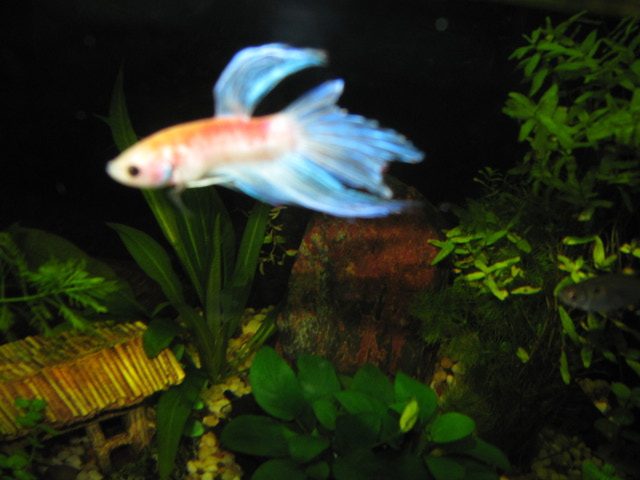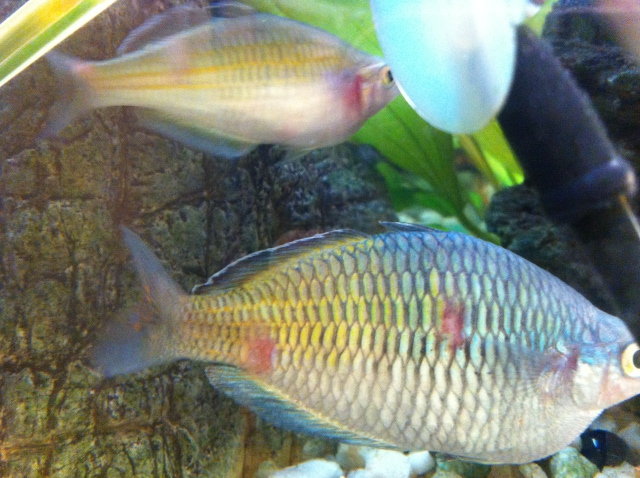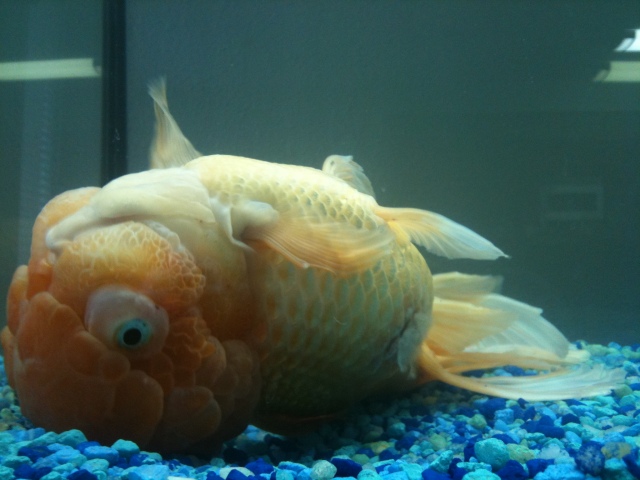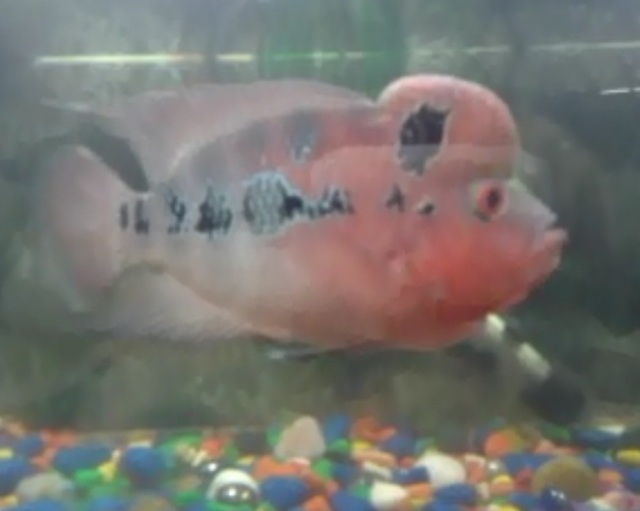QuestionI had this 29 gallon fish tank set up for about a week now and there is 4 Fancy goldfish which I got all at once from the same fishtank at the pet store. I have a fiter,carbon and ammonia filter. I tried a few months ago to have gold fish and the fish tank got this whitish, almost clear thing that is attached but its kinda has this tail thing floating off of it on the inside walls of the fish tank, and they're very small, originally I thought it was Ick and thats how I treated it and it didn't seem to do any good and they eventually all died. But it wasn't ever really on the fish and everywhere I've read they describe it more on the fish and crystal like but this is different. At first the fish don't seemed to be bothered by it but eventually they get sluggish then they look like they are breahing hard and they don't really swim unless they have to, they just lay there. And it comes up very rapidly, like I came home around 5 from work and things looked fine, then 6 hours later when I get back home, its all over the walls. I haven't had any luck trying to find any info on what this could be.
Thanks Jen
AnswerHi Jen;
You have 2 things going on. The main problem is "New Tank Syndrome". I will include my article on new tanks at the end of this letter.
The second probem is planaria. They are harmless to your fish, but are a sign of overfeeding. I've had them before too. We all overfeed from time to time. We just have to remember to clean up after ourselves when we do. They grow like crazy on the excess fish waste and excess food. Once you cut back on food they will slowly go away. The fish may not be very hungry right now because of toxins that have built up in the tank from "new tank syndrome". Feed them only what they can totally consume within 5 minutes from all over the tank. Any more than that and it just add to excess waste. Even if they eat all the excess food, they don't digest it properly.
More about new tanks;
**********
New Tank Syndrome or Break-in Period
So you have a new tank and you filled it up, put the filter together, mounted the heater into place and turned on the lights. You have all the plants and decorations where you want them....
You are ready for fish.
But, your filter is not ready for a full tank of fish yet.
The filter is running and moving the water and cleaning out crud, right? Of course!
But a very important part of your filter is the part you can't see. An aquarium filter removes the larger visible stuff, but it also must remove the dissolved fish waste that turns into ammonia in the water. To do this, special bacteria must grow in the filter system and on the particles of gravel in the bottom of your tank. This process occurs even on a limited scale in little fish bowls that have no filter in them.
This is "New-Tank Syndrome" or the "Break-in Period". The entire process takes 6 to 8 weeks to complete because these "nitrifying" bacteria grow quite slowly.
Start off with only two hardy fish for every ten gallons of water and don't add more until the 6 to 8 weeks has gone by. Hard to be patient, but it is worth it to keep your fish alive and healthy. As a matter of fact, the bacteria cannot develop without fish in the tank. You can let that tank sit forever without fish in it, but as soon as the first fish goes in the process begins. Avoid changing the filter pads during break-in. This removes the bacterial colonies that are essential to a balanced aquarium. You can rinse the filter pad out in a container of aquarium water. This will preserve most of the bacteria colonies while still allowing your filter to flow freely. Even using bacteria additives and water conditioners when you first set up the tank will not make a tank cycle by itself. If there are no fish to provide food (fish waste) for the bacteria, the beneficial bacteria cultures will die and you will have to start the colonies all over again once fish are added to the tank.
Feed your new fish VERY lightly. Any excess food will cause additional waste your system cannot afford to have right now. If you see food floating around or lying on the plants and gravel after five minutes, too much food is going into the tank. Cut back a little each time you feed until it is ALL gone 5 minutes after you feed them.
During this "break-in period" your tank will become cloudy and milky looking. You may have to tolerate this for the entire break-in period but it is only temporary. Changing 25% of the water three times a week until the break-in period is over helps a great deal. Changing water reduces the ammonia and nitrites that rise while the bacteria continues to multiply. If ammonia and/or nitrites become too high, your fish will become stressed and possibly die. Use a good water conditioner when you replace the water and make sure it is the right temperature to avoid shocking your fish.
When the break-in is over after 6 to 8 weeks and there are no nitrites or ammonia present in the water you can slowly add more fish. Add one or two every week until you reach the desired population. This allows the bacteria to adjust to the new population every time before adding more. Monitor the nitrites and ammonia to be sure they don't come up. If they do, make a 25% water change and check them again. Don't add the next fish until the levels are down again.
The safe maximum population for any size tank is one inch of adult fish for every gallon of water in the tank. Do some research to be sure of the fish you are interested in. Even though they are small when you buy them, you have to base your population calculations on full-sized adult fish. Many hobbyists have up to two inches per gallon but this can be risky. If a water quality issue arises or a disease occurs it will spread fast and furious in an over-populated tank. In any case, 25% water changes every week to two weeks are absolutely essential for the health of your fish.
Following these guidelines will help you get your new tank on the right track.
**********
Followups welcome
At Your Service;
Chris Robbins
Come on over and join us on the freshwater fish forum at About.com to get even more information too;
http://forums.about.com/ab-freshaquaria/start
My member name is ChrisR62. See You There!

 Fin Rot :-(
QuestionQUESTION: Hello Jaymie,
I am so concerned about
Fin Rot :-(
QuestionQUESTION: Hello Jaymie,
I am so concerned about
 Columnaris/Costia?
QuestionBosmani with bumps
Scales missing
Columnaris/Costia?
QuestionBosmani with bumps
Scales missing
 Swim bladder disorder in Lionhead Oranda
Question
Fuzzy spot
Hello! I have been doing res
Swim bladder disorder in Lionhead Oranda
Question
Fuzzy spot
Hello! I have been doing res
 A Catfish I purchased.
Question
The Catfish
Hi, I purchased a catfish yesterda
A Catfish I purchased.
Question
The Catfish
Hi, I purchased a catfish yesterda
 Need Information about Flowerhorn
Question
Flowerhorn
Dear Sir,
Iam Prakash from
Need Information about Flowerhorn
Question
Flowerhorn
Dear Sir,
Iam Prakash from